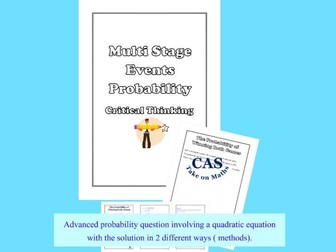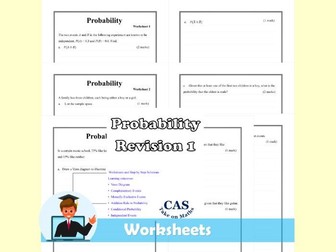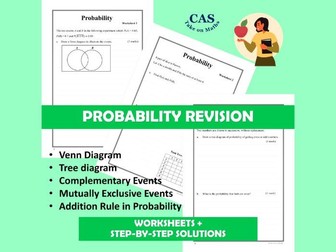Advanced Probability - The Probability of Winning Both Games
<p><strong>ADVANCED PROBABILITY QUESTION</strong><br />
about multi-stage event probability and step by step solution in two different ways (methods).</p>
<p>Students think critically to solve the ŌĆ£Probability of Winning Both GamesŌĆØ question. This challenge question requires students to use their knowledge & understanding of probability concepts and to come up with mathematical strategies to solve the problem.</p>
<p><strong>Learning Outcomes:</strong></p>
<p>ŌĆó Use arrays or tree diagrams to determine the outcomes and the probabilities for multi-stage events.</p>
<p>ŌĆó Understand events using the language of ŌĆśequally likelyŌĆÖ, ŌĆśat leastŌĆÖ, etc.</p>
<p>ŌĆó Use complementary event to determine the probabilities associated with simple games.</p>
<p>ŌĆó Use & solve a quadratic equation form that related to the probability of multi-stage events.</p>
<p><strong>Also comply with Australian Curriculum</strong></p>
<p>Identify complementary events and use the sum of probabilities to solve problems (ACMSP204)</p>
<p>Describe events using language of ŌĆśat leastŌĆÖ, exclusive ŌĆśorŌĆÖ (A or B but not both), inclusive ŌĆśorŌĆÖ (A or B or both) and ŌĆśandŌĆÖ. (ACMSP205)</p>
<p>Describe the results of two- and three-step chance experiments, both with and without replacement, assign probabilities to outcomes and determine probabilities of events. Investigate the concept of independence (ACMSP246)</p>
<p>Simple probabilities: construct a sample space for an experiment (ACMEM154)</p>
<p>Use a sample space to determine the probability of outcomes for an experiment (ACMEM155)</p>
<p>Use arrays or tree diagrams to determine the outcomes and the probabilities for experiments. (ACMEM156)</p>
<p>Probability applications: determine the probabilities associated with simple games (ACMEM157)</p>
<p><a href="/resources/search/?q=probability%20castakeonmaths">Probability</a></p>


